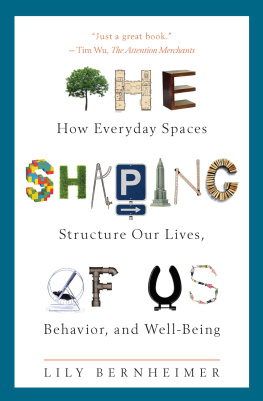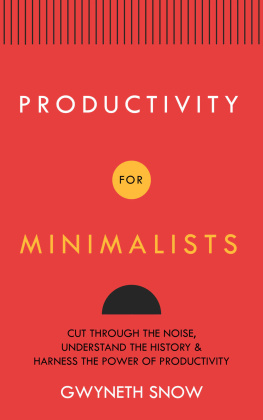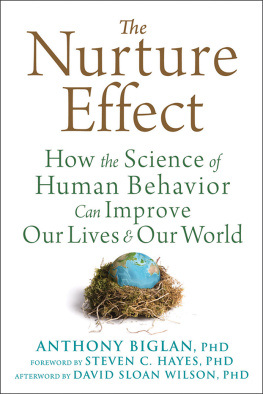
The Shaping of Us
How Everyday Spaces Structure Our Lives, Behavior, and Well-Being
Lily Bernheimer
TRINITY UNIVERSITY PRESS
San Antonio, Texas
To two people whose collaboration this book is greatly indebted to: my parents
Published by Trinity University Press
San Antonio, Texas 78212
Copyright 2017, 2019 by Lily Bernheimer
First published in the United Kingdom by Robinson, an imprint of Little Brown Book Group
All rights reserved.
No part of this book may be reproduced in any form or by any electronic or mechanical means, including information storage and retrieval systems, without permission in writing from the publisher.
Jacket design: Jamie Keenan
Images Deposit Photos / iStock / Shutterstock
Illustrations on courtesy of Grace Exley
Illustrations following by Maxwell Flood, courtesy of Headspace Group
From the song Little Boxes, words and music by Malvina Reynolds, copyright 1962 Schroder Music Co. (ASCAP); renewed 1990; used by permission
Some of the characters in this book are fictional amalgams of people the author has come across in real life; a small number have had names and other identifying features altered to protect their identity
ISBN 978-1-59534-872-2 hardcover
ISBN 978-1-59534-873-9 ebook
Trinity University Press strives to produce its books using methods and materials in an environmentally sensitive manner. We favor working with manufacturers that practice sustainable management of all natural resources, produce paper using recycled stock, and manage forests with the best possible practices for people, biodiversity, and sustainability. The press is a member of the Green Press Initiative, a nonprofit program dedicated to supporting publishers in their efforts to reduce their impacts on endangered forests, climate change, and forest-dependent communities.
The paper used in this publication meets the minimum requirements of the American National Standard for Information SciencesPermanence of Paper for Printed Library Materials, ANSI 39.48-1992.
CIP data on file at the Library of Congress
23 22 21 20 19|5 4 3 2 1
Contents
We treat space somewhat as we treat sex.
It is there but we dont talk about it.
Edward T. Hall
Preface
T he spaces we live in shape our lives. They impact our feelings, behaviour, identities, and even how quickly we can solve puzzles. The environments we spend time in can make us healthier, decrease our perception of pain, and make us less likely to litter. Space is like a secret script directing our actions. Its a script we play a part in writing by choosing where to work, who to socialise with, and how to decorate our homes. But like the actors in a play, we maintain the illusion that our actions are unscripted.
Remember the first time you went to a foreign country. Money is strange, and people stand close, and the street is a jungle of forms. Youve gone off script. We know intuitively that space is essential to who we are as individuals and societies. But oddly, we dont acknowledge how much it moulds us. This may be because its so difficult to pin down how an environment affects us. Consider why so many people prefer older houses, and why our modern attempts to mimic them tend to fail so spectacularly. Is it the outside appearance, the craftsmanship, the building materials, the towns around them, or the way we interact with people in them?
Our behaviour is often counter-intuitive. We believe that traffic lights and curbs keep us safe, but have fewer accidents when we are forced to pay attention to our surroundings. We build promising parks that no one uses, and install energy smart meters that we then ignore. How does a desolate walkway become a bustling social centre and why do communities rally to save certain derelict buildings?
We like spaces that flirt with us complex and mysterious settings without threatening the achievement of our goals. The built environment supports our well-being best when it echoes the natural world in some way through pattern, dimension, light, layout, noise the scale and tone of the world that we were built for.
The Shaping of Us exposes how our surroundings shape us, and what the shape of our environments says about us. Through public space, housing, workspaces, healthcare facilities, and cities, I uncover how space mediates community, creativity, and identity. I examine the experiences of different cultures and personality types, and the benefits of grassroots and mainstream approaches to building. What makes spaces work and what may become of us if we dont listen to what we know is good for us. I trace how the environments we inhabit make us who we are from the earliest moments of our evolution to the worlds we build around us.
Note: This book was originally published in Britain and largely retains British spelling and grammar.
Introduction
We shape our buildings, and afterwards our buildings shape us.
Winston Churchill
T his is not a book about nature versus nurture.
Its about both.
The environments we inhabit shape us so profoundly that their influence defies this distinction.
Winston Churchill was right to an extent. Because humans have been around far longer than buildings. And before buildings, the elements and environments of our natural habitats shaped us as well.
The Shaping of Us traces how our perceptual systems and preferences developed in relation to the environments we evolved in. How we developed shelters, aesthetics, and settlements in reaction to these inclinations. How we have slowly lost this basic ability to build and maintain environments we flourish in. And how we can get it back.
I will reveal how we are formed by our homes, streets, and neighbourhoods, and what the shape of these spaces says about us. How landscapes and cityscapes define us individually, collectively, and culturally and how we use them to define ourselves. Even how we change from moment to moment, from one place to another.
We like to believe that we are consistent and logical, that our identities hold firm across our lives. But do they? We say What happens in Vegas stays in Vegas. As if our actions there arent our own as if we arent ourselves in foreign settings.
In 1971, two US congressmen visited Vietnam and made a disturbing discovery: large numbers of the American armed forces were addicted to heroin. Thirty-five per cent of servicemen had tried heroin, and nineteen per cent became actively addicted. The American public was horrified, and the government reacted swiftly. President Richard Nixon created a new office, the Special Action Office of Drug Abuse Prevention, to combat these new narcotic enemies.
The office first set up a system to test urine samples and treat addicts in Vietnam before they returned home. Next, they appointed a leading psychiatric researcher named Lee Robins to study the full extent and implications of the epidemic. And this is where the story takes a strange turn. Robins found that Vietnam veterans had an astonishingly low rate of relapsing to heroin addiction once they returned home. Standard relapse rates are generally around eighty-seven per cent, but only twelve per cent of veterans addicted in Vietnam had experienced any episode of re-addiction in the US. At this time, heroin was widely believed to be so powerfully addictive that a single dose could doom its victims to lifelong dependency.
What could explain this shocking disconnect? It wasnt simply a lack of access. Half of those addicted in Vietnam had used narcotics at least once upon returning to the US, but only a small portion continued. And, surprisingly, few of the young men they interviewed attributed their drug use to the stress of warfare. Most began using before they actually entered combat, and those
Next page













